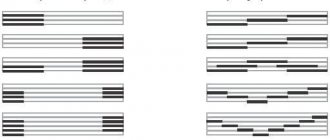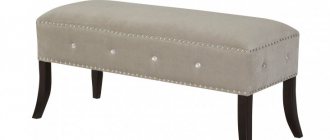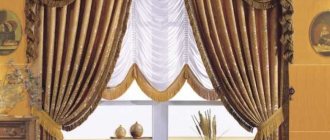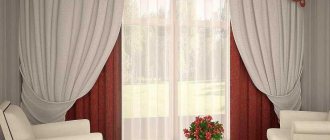Restraint and oriental minimalism quickly gained immense popularity among designers and buyers. In the world of design, the Japanese have long been leaders, offering the market new ideas and technologies. Lovers of exotic home decoration should think about Japanese curtains.
Having chosen this direction, you must take into account that not every interior will fit well with Japanese-style curtains. The most suitable would be minimalism or high-tech style.
Innovation of Japanese curtains
Japanese curtain panels are similar to blinds. These are canvases in separate cassettes. The cord can be used to control the panels. An innovative solution was a remote control for adjusting curtains from a distance.
Curtain panels consist of equal panels that are attached to the cornice. In this way they are similar to vertical blinds, but there is no possibility to rotate the slats. But you can move the whole canvas to the sides to adjust the light or get a better view.
What interiors are Japanese curtains suitable for?
Ideally, the room in which Japanese curtains are to be installed should be spacious, with large window openings. In small rooms they most often create a cluttered effect. But if you choose their color and design with special care, then you can fit them organically into a small bedroom.
It is natural to assume that the curtains that came to our homes from the Land of the Rising Sun will look best in interiors that contain the main features of the Japanese style. Namely:
- Minimalism. The setting contains everything you need, but nothing superfluous.
- Close to nature. Finishing materials, furniture and textiles are made from natural materials.
- The color scheme of such an interior should be calm, discreet, with a predominance of shades of white, beige, green, gray, and brown. If the owners of the bedroom prefer brighter colors: black, red, purple, blue, they can use them as additional ones. The main thing is to avoid excessive diversity.
In what areas can Japanese panels be used?
If you have avant-garde style furniture in a large room with the same windows, then Japanese window panels are a great option.
The range of their applications is wide; they can be used as partitions (screens) in a room. They can cover a baby’s crib, highlight a wardrobe in the hallway, or divide a room.
In living rooms, brighter colors or a combination of opposites are chosen.
Japanese curtains in the kitchen interior are also an interesting option. Light shades will refresh the small size of the kitchen and visually expand it. The versatility of Japanese curtain panels gives great possibilities and is easy to combine with furniture or flooring. And if they become dirty, they can be replaced.
Options for combining Japanese curtains
For greater practicality or unusual and interesting visual solutions, you can combine Japanese curtains from different materials or combine them with other design options for windows and doorways.
How to combine Japanese curtains of different colors Source otto.ru
A combination of transparent and thick curtains in the Japanese style Source www.shtora.ooo
How to combine several options for Japanese curtains on one window Source blog.postel-deluxe.ru
How to combine Japanese-style curtains with tulle Source moskva-shtora.ru
The main thing to remember when choosing combinations is overall simplicity and restraint. That is, Japanese panels will look good, for example, with light tulle or simple linen curtains with or without a discreet pattern. But complex options with lace and drapery will not work.
Decoration in pink tones Source tekstilprofi.com
In Japanese style Source tvojdizajn.ru
Strict blue curtains Source profdekor.ru
Types of fabric
It is not difficult to sew such curtains with your own hands; you can choose thick or thin fabrics. Preference should be given to natural materials. Traditionally, cotton fabrics, linen or silk are chosen. Bamboo and woven jute will help bring exoticism into your home.
First, look at examples of photos of Japanese curtains in catalogs to successfully arrange the panels. The Japanese tradition has a peaceful and calm palette of colors. Shades of cream, blue or green are ideal. Oriental laconicism throughout; an original option would be a variety of hieroglyphs or oriental images with vegetation.
A fashionable solution has become to combine several canvases of different colors. For example, white color harmonizes perfectly with colors or patterns. It is recommended to alternate plain and colored panels; a smooth transition from one color to another is possible.
How to care for screen curtains
Caring for curtains in Japanese style depends on what material was used to sew them. Fabric panels can be placed in the washing machine.
In this case, you must strictly adhere to the instructions and set the delicate wash mode. Simply wipe the plastic product with a soapy sponge. To clean the bamboo structure, you will need a vacuum cleaner.
After Japanese curtains are cleaned or washed, they are immediately hung without waiting for them to dry completely so that they acquire a smoothed appearance.
A Japanese curtain in the interior opens up wide scope for design ideas. It does not clutter up the space, but on the contrary, adds novelty and originality to it. With it you can create a design in different colors and textures that will bring an atmosphere of comfort and coziness to the room.
Making your own curtains
To make Japanese curtains, you need to have sewing skills. First you need to cut out the required number of identical panels. Based on the size of the window, you need to correctly calculate the width of the curtains, since the cornice for Japanese curtains is standard.
Allowances for fabric shrinkage, weights and Velcro are required. The finished panels must be ironed well for perfectly even shapes.
Mounting options and types of cornices
Curtain panels can be fastened:
- to the ceiling;
- to the floor;
- to Wall.
As for the cornice for Japanese curtains, it comes in different designs. Here are some of the most popular options:
- Tire. Such a cornice is represented by several rows of tires (up to 5 pieces). Curtains are attached to each of them. The upper part of the canvas is fixed with Velcro tape. A weighting agent is attached to the bottom edge of the panels.
- Tubular. Traditional option. Tubular cornices can be made of wood, metal, or plastic. Such designs involve attaching curtains to rings or fabric loops.
Panel management
The curtains can be adjusted with a cord or an automatic remote control. Five-row panels are best controlled with a stylish remote control.
Easy to make and functional, Japanese photo curtains in the interior will add an extraordinary airy atmosphere. This strict elegance of Eastern culture will appeal to many.
Selecting Japanese-style panels for kitchen decoration
There are several criteria that you need to pay attention to when choosing Japanese curtains for the kitchen.
- Length. The more spacious the kitchen space, the longer the curtains can be. In small rooms, it is recommended to limit products to the window sill. It is important to remember about the weights that are located at the bottom of the canvases. They will prevent the fabric from curling and ensure there are no wrinkles.
- Color. The colors of the fabric can be different - from natural calm shades, considered oriental classics, to a bright modern palette. When choosing a suitable range, we must not forget about the laconicism of the images. You should not experiment with contrasts and “poisonous” tones.
- Presence of ornament. On plain, almost transparent fabrics, fine and clear lettering is acceptable. Large flowers look good against a restrained but rich background. When choosing an interesting design, you should not limit yourself to traditional hieroglyphs or dragons - watercolor painting is no less appropriate for oriental motifs.
- Canvas material. It is not necessary to make ensembles from the same type of fabric. You can combine organza with linen, taffeta with thick silk - there are many options. When choosing a material, it is important to consider its functionality and practicality. Loose fabrics will quickly absorb kitchen odors, moisture and grease, losing their attractiveness. For the kitchen, materials with the addition of synthetic fibers are preferable.
Related article: Grinder Makita 230
Rules for caring for Japanese curtains ↑
The flat panels, just like regular curtains, accumulate dust, so they need to be cleaned periodically. The best option is dry cleaning with a vacuum cleaner or a slightly damp brush. It is better to vacuum without removing the curtains from the curtain rod.
With good care, the curtains will be like new. By the way, the photo shows an interesting combination - Japanese panels and a Roman blind
If stains appear, you need to use a sponge - first, carefully wash off the dirt with a soap solution, then remove the soap suds with clean water. Products cannot be washed, as they may lose one of their main qualities - their strict rectangular (or square) shape. If there is a need for serious, higher-quality cleaning, use dry cleaning services.
Choosing fabric for screened Japanese curtains
When covering a window with panel curtains, instead of tulle, a transparent plain fabric that allows light to pass through is recommended. At the bottom of the panels there is a weighting bar. It provides the perfect shape to the curtains and keeps lightweight materials from swaying in a draft.
For functional curtains, any thick fabric that blocks light is suitable. The design can be anything, but harmony in the interior is important. To add more individuality, curtains can be decorated with applique or stencil designs. The paint of the “print” with your own hands will not wash off if you use a master class in the “batik” technique.
For fabric screens for partitions in room zoning, decorative fabric that matches well with the rest of the decor is suitable. A special cornice can be mounted not only at the window, but also stretched from the ceiling to the floor (with the bottom strip attached). The length of sandwich panels may vary.
Japanese-style fabric panels are not decorated with fringe, ruffles, bows, tiebacks and other additions. But a layer-by-layer combination of materials of different textures is possible, including the addition of thread curtains. Fabrics with different effects are used as decoration:
- with a large pattern in the Japanese style (bamboo, geishas, strange birds, waterfalls, cherry blossoms, bonsai);
- corrugated or pleated (vertical or horizontal creases);
- with a “gradient” effect (the color gradually changes to another or dissolves);
- ornament with a 3D effect (a sense of volume);
- imitation drawing (copy of the texture of materials - cork, bamboo, wood).
DIY Japanese curtains
Due to the simplicity of the mechanism, Japanese panels can easily be made independently. To do this, you will need, to choose from, materials such as:
- Linen.
- Cotton.
- Silk.
- Bamboo.
- Rice paper.
- Plastic.
- Reed.
- Rattan.
The finished design of the cornice can be purchased in a store or ordered online. It is noteworthy that the cornice is equipped with a special Velcro to which the fabric sheet is attached.
The first step in making Japanese curtains will be cutting the fabric. To do this, you should carefully measure the width of the window opening and divide the result into 60 cm segments. For example, if the opening width is 120 cm, then 2 panels must be made accordingly.
The length of the panel is determined by measuring the distance from the floor to the cornice and adding 10 cm for hem. Fabric yardage is calculated by multiplying the length by the number of panels required.
Manufacturing process:
- Processing the edges and sides of the panels.
- Careful ironing.
- Ironing the Velcro to achieve the required level of shrinkage.
- Velcro is sewn to the fabric from the wrong side to disguise it.
- Stitching Velcro on the front side.
- Repeated ironing of the fabric.
- Fastening the canvas to the holder.











